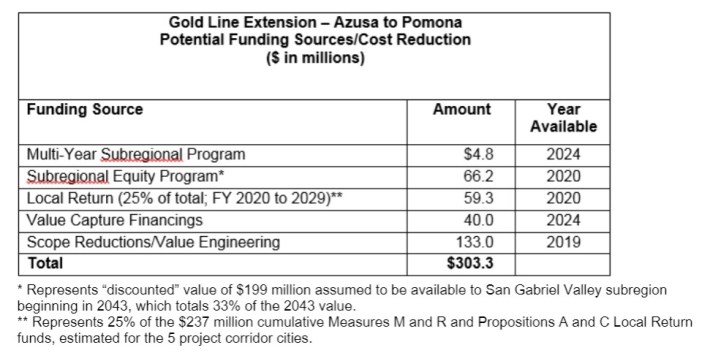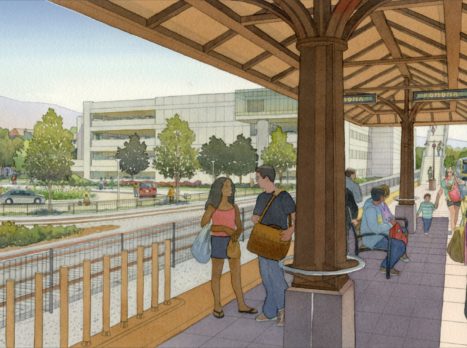Yesterday, Metro's Construction Committee voted to support extending the Foothill Gold Line to Pomona. Though final phasing and funding details still need to be nailed down, Foothill Gold Line construction is expected to get underway later this year.
The Foothill Gold Line phase 2B is a complex project. It will be 12.3-miles long, extending from the current Gold Line terminus in Azusa to the city of Montclair, just across the L.A. County border in San Bernardino County. There will be six new stations, one each in the cities of Glendora, San Dimas, La Verne, Pomona, Claremont, and Montclair. In addition to spanning city and county jurisdictions, construction includes station and track relocation within an active rail right-of-way, shared with Metrolink and freight rail. Though the line will be owned and operated by Metro, it will be built by the Foothill Gold Line Construction Authority.
When the groundbreaking celebration took place in late 2017, things were moving along smoothly for the new Foothill Gold Line extension. Early utility work was underway. Funding was nearly all in place. San Gabriel Valley stakeholders were excited that theirs was the first Measure M rail project out of the gates.
The project gained more momentum last April, when the California State Transportation Agency awarded gas tax monies to close a funding gap. The project received a $249 million Transit and Intercity Rail Capital Program (TIRCP) grant. With full funding in hand, the construction authority put remaining project construction out to bid.
Then, when bids were unveiled, the extension hit a snag.
Construction costs had already been creeping upward. In 2016, the estimated cost was $1.2 billion. At the end of 2017 the estimate was $1.5 billion. In November, 2018, with actual construction bids in hand, that estimate jumped to $2.1 billion. The construction authority attributed the "runaway" escalation to a combination of factors, including an overheated construction market and steel tariffs.
The construction authority scrambled to modify the project to get some construction underway before costs escalated any further. In November, the authority took steps to truncate the project, with a plan to build only as much of the line that the $1.5 billion in hand would fully fund. The authority's plan was to green light an eight-mile three-station extension ending in the city of La Verne. Proceeding with Gold Line construction to La Verne was (and still is) expected to get the go-ahead this summer. The construction contract would include an option that allows the authority two years to add-on the full project to Montclair. If Metro and the authority can line up full funding (securing an additional $0.6 billion) by mid-2021, then the full project remains on track for 2028 completion. If additional funds are not lined up, then construction to La Verne is expected to be completed in 2024.
In December, the Metro board passed a motion directing the agency to work with the construction authority to identify funds to build the full Gold Line extension. The motion mandated a report back "with options for initial funding to extend the first phase beyond La Verne to Pomona." The Metro board Construction Committee received that Metro staff report yesterday.
The main point of debate yesterday is whether the truncated initial phase can be extended an additional mile to reach the city of Pomona. Current funding is enough to reach LaVerne, but falls $230 million short of what is needed to reach Pomona. Agency staff have identified potential funding sources, these are not yet guaranteed.
Metro staff analyzed various potential funding sources: (see much greater detail in staff report)
- Cost Reductions - General: Metro and the authority identified a total of $133 million in savings from reducing the project scope. For the most part, these savings do not actually mean changing what would get built, but essentially reduce some extra contingencies in the budget - including some Metro and authority staff time. The only tangible output expected to change would be a reduction in the quantity of rail cars procured.
- Cost Reductions - Parking: Metro's staff report further mentions that additional cost savings from downsizing parking "may also be considered." In 2017, Streetsblog L.A.'s conservative ballpark estimate for phase 2B Gold Line parking would be $86 million for the planned 3,580 new spaces in five above-ground parking structures.
- Local Funding: Metro proposed subregional Measure M funding, sales tax (Measures M and R, Propositions A and C) local return, and new value capture financing via local tax increment. None of these funds come easy. Shifting funding to the Gold Line would take funds away from other transportation projects.
- State Funding: The entire 2B phase already received state TIRCP funds. Metro staff expect that additional state grant funds would not be probable, given a scope decrease and a cost increase. More state funding should be possible over time, but securing it right away appears unlikely.
- Federal Funding: Even if the current administration were not starving transit funding, the Gold Line project was not cleared under federal environmental law, so it would be prohibitively difficult to use federal funds.
Overall, Metro's staff report shows a potential $303.3 million in potential funding: (note: Metro staff mentioned a revised estimate, but still about $300 million)

Though $300 million looks like more than enough to make up for a $230 million gap, it seems very unlikely that all of this potential funding would be realized. Value capture is certainly possible, but would require plenty of political will and, probably, local voter approval. Reassigning local return funds would impact city transportation budgets - even just at Metro's assumption of 25 percent of 10 years of local returns. None of the subregional, local return, or value capture funding would be approved before the Metro board votes next week.
(Reducing parking is not included in the above chart. Though some park-and-ride is arguably needed for some suburban Gold Line riders, reducing parking would be a certain cost reduction. It would also be good for equity and the environment. Four of the five Gold Line phase 2B cities opposed an earlier Metro station parking plan that called for reducing parking. Perhaps if cities face a trade-off between letting go of some planned parking or some local return money, they might choose to support reduced parking.)
Staff also analyzed similar funding strategies to get initial construction to Claremont, but this appears less doable.
Extending the next Gold Line phase to Pomona or La Verne would have winners and losers. San Gabriel Valley interests, formerly strongly united in support of extending the Gold Line, are now at odds with each other. At yesterday's meeting, Pomona mayor Tim Sandoval spoke in favor of extending rail to his city. Representatives from Claremont and La Verne San Dimas, cities both east and west of Pomona, spoke against the proposal; both were highly critical of using local return or value capture to pay for the Gold Line.
Metro boardmembers John Fasana and Hilda Solis, both of whom represent the San Gabriel Valley, expressed their support for including Pomona in the next phase of Gold Line construction. Fasana outlined transit connectivity benefits; getting to Pomona would connect the Gold Line with Metrolink's San Bernardino Line. Solis emphasized connecting to Pomona to serve equity, as Pomona is the most economically disadvantaged community along phase 2B.
Fasana and Solis acknowledged that the funding is not quite there, with Fasana stating that Metro and the authority "don't have the money" and Solis suggesting that under California's new governor, more state funding might be an option.
Nonetheless, Fasana urged "We've got to get this thing to Pomona now... time is of the essence."
The Construction Committee unanimously approved directing Metro's CEO to work with the construction authority to ensure the next Gold Line extension gets to Pomona. This sets the stage for likely approval by the full Metro board at its meeting next Thursday, though final funding sources will likely remain unresolved then.
The approve-now fund-later approach is likely to have political support now, but later trade-offs could cause later tensions. These tensions could be among Gold Line cities, among different parts of the San Gabriel Valley subregion, and even among different subregions in L.A. County. All these jurisdictions are looking to build and/or accelerate their own projects. Construction costs are rising for everyone, so other projects are facing shortfalls.
The Gold Line authority is expected to discuss the extension when its board meets next Wednesday. In late January, the authority expects to issue an addendum to design-build teams to nail down phasing and other aspects of construction. The authority anticipates awarding the construction contract in June or July. This would get construction underway, and, as mentioned above, with either a La Verne or Pomona temporary terminus, Metro and the authority would have two years to line up the additional $0.6 billion to finish the entire line.
SBLA San Gabriel Valley coverage is supported by Foothill Transit, offering car-free travel throughout the San Gabriel Valley with connections to the new Gold Line Stations across the Foothills and Commuter Express lines traveling into the heart of downtown L.A. To plan your trip, visit Foothill Transit. “Foothill Transit. Going Good Places.”







